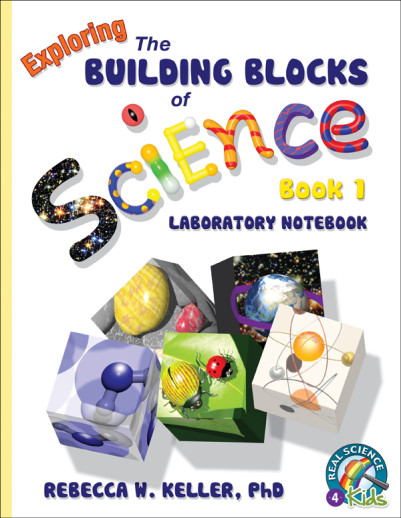We use cookies to make your experience better. To comply with the new e-Privacy directive, we need to ask for your consent to set the cookies. Learn more.
Exploring the Building Blocks of Science Book 1 Laboratory Workbook
SKU
024094
ISBN
9781936114313
Grade 1
Neutral
Medium Teacher Involvement
Multi-Sensory
Other Materials Required
Spiral
These icons are designed to help you quickly understand and learn important information about our products.
Teaching Method
Traditional
Teacher-centered curriculum commonly used in classrooms that may include a text, teacher manual, tests, etc.
Charlotte Mason
A methodology based on the work of a 19th century educator who maintained that children learn best from literature (Living Books), not textbooks.
Classical
A methodology based on the Latin Trivium (three stages of learning), including the grammar stage (memorization and facts), logic stage (critical thinking), and rhetoric stage (developing/defending ideas).
Unit Study
A thematic or topical approach centered around one topic that integrates multiple subject areas.
Montessori (Discovery)
A methodology based on the work of a 20th century educator that emphasizes student and sensory-driven discovery learning and real-life applications.
Other
Other methodologies
Religious Content
Secular
Contains content contrary to common Christian beliefs (i.e. evolution).
Neutral
Avoids religious or theoretical topics or presents multiple viewpoints without preference.
Christian/Religious
Faith-based or including instructional religious content.
Learning Modality
Auditory
Learns through listening, talking out loud or reading out loud.
Visual
Learns through seeing, prefers written instructions and visual materials.
Kinesthetic/Tactile (Hands-On)
Learns through moving, doing and touching.
Multi-Sensory
Curriculum that employ a variety of activities/components.
Presentation
Sequential
Curriculum progresses through well-defined learning objectives. Emphasizes mastery before moving to the next topic.
Spiral
Topics and concepts are repeated from level to level, adding more depth at each pass and connecting with review.
Conceptual/Topical
Focus is on the “why,” often with a unifying concept as well as specific skills; coverage may be broader.
Teacher Involvement
Low Teacher Involvement
Student-led materials; parent acts as a facilitator.
Medium Teacher Involvement
A mix of teacher-led time and independent student work.
High Teacher Involvement
Teacher-led lessons; may utilize discussions, hands-on activities and working together.
Additional Materials Required
No other materials needed
Everything you need is included.
Other Materials Required
There are additional required resources that are a separate purchase.
Other Materials Optional
There are additional resources mentioned or recommended but are not absolutely necessary.
Consumable
Consumable
Designed to be written in; not reusable.
Non-Consumable
Not designed to be written in; reusable.
Our Price
$46.00 $46.00 $32.25
Rainbow Savings: $13.75
Description
Students will look at the question, "What is Science?" while covering topics such as: atoms, molecules, types of energy, the earth's layers, earth in space, our solar system, cells, viruses and bacteria, classification and more. The Laboratory Notebook is a very important part of the program. This consumable book offers 44 experiments intended to complement the chapters found in the student text.
Publisher's Description of Exploring the Building Blocks of Science Book 1 Laboratory Workbook
Building Blocks Product descriptions_1Building Blocks Student Textbook - Introduce students to real science with the Exploring the Building Blocks of Science Student Textbook. Foundational scientific concepts and terminology are presented clearly and in a manner that's easy for kids to understand. Using this book gives kids a solid base on which to build a further study of science. This year-long curriculum contains four chapters of each of five scientific disciplines: chemistry, biology, physics, geology, and astronomy, as well as an introduction to the material covered and a concluding chapter for a total of 22 chapters. The many graphics in this full color textbook reinforce the concepts presented and make the book fun for kids and teachers alike to read. Building Blocks of Science Laboratory Workbook - Introduce kids to the excitement of doing hands-on, real science experiments with the Exploring the Building Blocks of Science Laboratory Notebook. Each easy to perform experiment encourages students to use critical thinking skills and is organized around the scientific methodthe process real scientists follow in doing experiments. Inexpensive common household items and foods are used for the experiments, and the setup time is minimal. There are two experiments that coincide with each of the 22 chapters of the Exploring the Building Blocks of Science Student Textbook44 experiments in all.Building Blocks of Science Teacher's Manual - Using the Exploring the Building Blocks of Science Teacher's Manual makes it easy for teachers to help students get the most out of the hands-on, real science experiments presented in the Exploring the Building Blocks of Science Laboratory Notebook. Instructions are provided for guiding students through the experimental process, and guided inquiry questions are suggested to help students think critically about the experiments they are performing. Inexpensive common household items and foods are used for most of the experiments, and a list of materials needed for each experiment is included.
Category Description for Exploring The Building Blocks Of Science Book 1
Students will look at the question, "What is Science?" while covering topics such as: atoms, molecules, types of energy, the earth's layers, earth in space, our solar system, cells, viruses and bacteria, classification and more. A typical week includes reading the chapter, performing the experiment, and review.
Details
| Product Format: | Paperback |
|---|---|
| Grade: | 1 |
| Brand: | Gravitas Publications |
| ISBN: | 9781936114313 |
| Length in Inches: | 11 |
| Width in Inches: | 8.5 |
| Height in Inches: | 0.5 |
| Weight in Pounds: | 1.55 |
Videos
Reviews
No Ratings
Be the first to review this item
Have a question? Ask owners.
Start typing and see existing answers.

